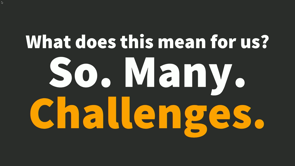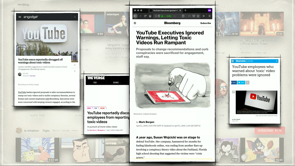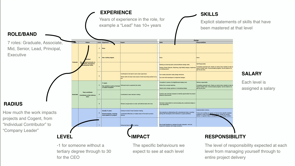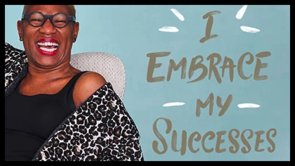Designing good experience for good experience designers
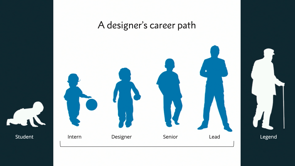
(pleasant electronic music) (audience applauds) - Am I here? Yes.
So, first of all, hi, and thanks to Web Directions for giving me a chance to share my thoughts here.
I'm Saurabh and that's like, that's pronounced like saw, like the cutting one and rub with a bit of 'h' towards the end.
(audience laugh) So, that's me! I am the Experience Design Director at a company called Sitback Solutions.
It's a human centred design and development agency based in Sydney.
We have a small team of designers and developers. It's like 35 people, all under one roof, and we work towards end-to-end solutions for various clients.
So, our clients actually range from government, to finance, to not-for-profit, and also touching something on E-commerce and education. So we work on a broad range of, for a broad range of clients.
And, in my team I do have, along with UX designers, product designers, researchers, I also have psychologists in my team.
And that's a very brutal combination to have, to have psychologists in your team because we all understand the importance of having research as an integral part of design. And who else knows or can understand humans better than psychologists? It's a good combination to have on our little team. And that's what we do from a company point of view, and I don't want to make it like a sales pitch. So, let met stick to the topic for today.
So, why is this topic important, designing good experience for good experience designers? In my past I have worked for different organisations and I have worked in different countries as well. I have interacted with design teams across the globe. I have worked in different domains myself, so, I started as an architect, I moved on to become a product designer, then automobile designer, I actually have like four bikes running on road that were designed by me. So, but I got bored of that.
And then I moved to UX and then to experience design. One thing that I notice is that, we always talk about the users.
We always talk about who we are creating for and we try to do the best for them.
But, what about the people that are doing it? What about us? What about the designers who are working towards those objectives? So, it is important to understand how we give them an environment where they can continuously innovate.
Where they have that freedom to explore more, where that have that freedom to create the future for that matter.
Like, big companies, the companies like Google or Facebook, they do have a lot of money to invest in resources and infrastructure.
They do have like free food, sleeping pods, they do have like good fancy offices and all that. Having a small company, ourselves, like we don't have that flexibility in terms of finances.
But we are pretty much aware of the need of doing that, need of having that environment in house.
So, today I'm going to talk about some of the things that we do internally.
These are going to be some quick fixes that we can all implement as design leaders in our teams. So, why experience design? It's not working but, okay.
So, why experience design? So, as I said, my team has a broad range of designers as well, so I chose experience design as, I think that it's an umbrella that covers all types of design fields that are working towards creating experiences for humans. So, I know we have talked about this before, that UX, how UX is different from experience design, and how different companies have different teams in there. What I try to find out, like, what experience design means from somebody who's, who I think like he's like me and he calls himself interdisciplinarian.
(laughs) It's very hard to pronounce.
and read as a word, but (laughs) but yeah, the way Ronald Jones described it is that experience design is about, is to persuade, is to stimulate, inform, envision, entertain, and forecast events, while at the same time influencing meaning. Meaning, and modifying human behaviour.
So that's the mission of experience design. And also it is important to understand what is the journey that a designer goes through. Let's say he starts from becoming, he starts from studying at a university about design. It actually starts much before that when you are actually a kid and trying to experiment with small things. And just trying to break apart every, each and every toy that you get and then try to fix it, just to fail every time. But then, that's where, so, for today let's stick to the university student. When a student enters the university there are two things that he enjoys and he can exploit.
First, is the time.
This is just moving on its own, so please excuse us. SO, he enjoys the time, and the freedom to experiment with new methodologies.
Experiment with new ways of working as well. And he's not confined to set ideologies, and not to deadlines of the projects, or not to the deliverables.
So, that is where they enjoy that freedom.
And, the same is with the legends.
I know it looks like Don Norman, but that's just accidental.
It's not intentional, I swear.
So, how and when that, that designer moves on to becoming a legend? That is the journey that I'm gonna focus on today. Now I've got, like, only 25 minutes to talk about, so it's a very small time period to talk more in details, but I'll try to cover as much as possible.
So this is a journey, this is a career path, this is a typical career path of a designer. Starts from becoming an intern at a company, moves on to becoming a junior designer, then to a senior designer, then to a leadership position, or a manager of a team.
And that is where all the drama happens.
That is where all the creativity is restricted. That is where you are confined to the deadlines, you are expected to deliver on time, on date, have to keep it to a budget.
And these are like anti-design things, anyways. So in order to understand what the journey is, I tried to talk to the designers themselves, and I did a small study.
I did some interviews with around 25 designers, and the balance that I kept was between the digital agencies and bigger organisations, because these are two different worlds where designers operate.
Not working.
The people that I talked to also had different years of experiences, so they had experiences ranging from zero to two years, to two to four years, four to six, and six plus years. They were also at different levels of seniority within their organisations, but there were a few things common amongst all of them. That was first the passion towards design, passion towards giving back to the society, or giving back to the world.
Utilising their powers, utilising the capabilities, skills. They all had dreams, they were all compassionate, they had curiosity, and one of the key things that they had was empathy.
And empathy is what actually separates out the design or the creative professionals from any other professional, from any other professions.
I also tried to understand what actually they think of the future.
What is their vision for the future? What way do they think it's all going? So they talked about something about fluid, mixed reality experiences, having machine learning, incorporating design in all aspects of life. Invisible interfaces, having design leaders in big organisations.
So this is like an interesting list of future vision, but is it really, is it really a future vision? And that is what concerns me right now.
We have seen Ikea App.
You don't have to actually go into a store, you can simply select a furniture, place it inside your room, and just have a feel of it. Just move around the furniture, visualise it, and it's very common these days to use these very basic AR or VR apps.
We all use Google Home.
Not all, but most of us mostly using Google Home, if not now then maybe in the next couple of years it'll be cheap, it'll be available to masses.
It's just a matter of some good business decisions, some marketing strategies.
But it still exists, it's not the future.
What about this movie? This actually came back in 1977, and that's where people were thinking about artificial intelligence.
They were thinking about driverless cars.
They were thinking about having drones, they were thinking about invisible interfaces. And that was back in 1977.
And if the designers of today, like 2019, if they are thinking in the same way, they cannot think beyond that, then there is a problem. It's like 50 years of gap, but the thinking is still there. I understand that these are things that are evolving with time.
I don't deny the fact that evolution itself is necessary, but at the same time, having that future vision. What's next, what's beyond the obvious, what's beyond the present? Thinking about that is in fact equally important. Talking about design leaders, we all know these people. If not these, then we know somebody, we know each other, we are all design leaders sitting here in this room.
I tried searching on LinkedIn for the Chief Design Officer.
I got like, almost equal to Australia's population of Chief Design Officers. (audience laughs)
I don't believe that, but there must be hundreds of design leaders that are already existing, and if we have design leaders like that, then obviously we have UX or XD as an integral part of onboarding or part of a culture.
So how does it affect us? How does it affect us as a community? It's running on its own. (audience laughs)
How does it affect us in terms of business, or in terms of the world? We all know these examples.
These were the market leaders at one point in time. They had good products, we cannot deny that. I can, in fact, pull out my Nokia phone from 1990s, and still throw it away, and it'll still work. They had that good products.
I don't think I can do that with any of the iPhones right now.
But what was lacking? Why did they suffer a major setback in their businesses? That was mainly because a lack of future vision. That was mainly because they could not see beyond what they were doing at that moment, and that is what is missing right now as well. So it's very important to make the designers in our teams, make them understand what powers they have. Whatever they do currently, how is it gonna affect the future? And how they can build or destroy the future, just by thinking or just by doing their regular work. And as in one of the Spiderman movies, that says that with great powers comes great responsibility. Stop, please. (audience laughs)
So it's very important to make them understand their responsibility as well.
So it covers most of the topics that were talked before as well, like moral. Your ethics, your responsibility towards the future. You have to use those powers.
You cannot just let it go.
Then as a design leader, what can we do, and how is it important for us to understand the difference between a production line worker and a designer? Just think about it, a production line worker has tools, yes, a designer has tools.
This person has environment to work, this person has environment to work.
He is being looked after by the company, yes, so is he, or her, whatever.
They both have similar resources available, but the only difference is the output that they're giving. The output from that person is going to be the same towards the end of each and every day.
Maybe throughout the life, that person is working on the same thing.
Let's say just working on, I was in automobile design, so it was like, just designing a headlamp of a motorcycle.
For example, a person working on that, works throughout his life if he's working on a production line just creating headlamps of the motorcycle.
But with a designer, if I ask him to design a headlamp of a motorcycle, he has to be able to design it different each and every time.
So it's very important for us as design leaders to encourage that kind of thinking.
So how can we help? These are some of the things that I think, from my experience, are useful, for me to share with all of you.
So the first one is having a right design leader. Now there are different hiring practises, I'm sure all of you have a checklist of items where, what you should look for in a design leader, but there are some of the key things that I would like to highlight.
First one is the vision of the future.
When I talk about designers having a vision of the future, it cannot happen, it cannot flourish 'til the time a design leader has that vision for the future. And I really appreciate the effort from John here while setting up the directions of the conference to segregate the design leaders from designers conference, so that we as design leaders as a community can talk about our experiences, and what we think towards the future.
Creating and nurturing an innovation environment. It's important to have good designers, it's important to have good skills, but until and unless you don't let them innovate, it doesn't make sense.
The design leader should be able to train for design leadership.
He should be able to pass on those skills, pass on that thinking, that vision for the future, to the junior designer so that they can become future design leaders.
Should be able to manage corporate relationships, you should be able to network the people.
Tim talked about having introvert design leaders, and I'm very grateful to him that he talked about how that introvert design leader can also, can also function well, or can also network with different people in different ways, so that's what is needed.
And that is also important, so the design leader can also predict the trends for the future.
Lead the team.
Once you have the design leader, the other thing is having the right team, and appreciate their individual motivations, individual passions.
To motivate what they think, what drives them to be in design field, what drives them to think about future, and what they think about it.
Let's say we have, let me get small people here, tiny people, again.
Let's say this is my team, are they all the same? We may have different people who are, maybe somebody is passionate about emerging technology, playing with games and all of that.
Somebody is passionate about research, and then someone is passionate about just giving back to the society.
And maybe we have some of the junior designers who are still confused, or who are just curious about everything, or who just are figuring out their passion. It's very important for a design leader to understand those motivations, and keep them into consideration while designing your team strategy, or team goals, as a whole.
Other thing is about building customised teams. Now I'm not talking about customised teams for regular project work, because that happens on the basis of like skills required, resources available, or the project requirements, or project objectives.
But I'm talking about work about innovation beyond that. So how can you bring people together, make smaller teams, and ask them to innovate beyond work? Let's say we buddy up a person with a research mindset with a person with an emerging technology mindset. There can be two outcomes of it.
One can be, we can have a good, futuristic technology, which is backed by a research, backed by some research data.
Other thing can be, we can have a new research method which we can achieve by having a new technology. So there are endless possibilities of doing that. Let's say we combine that same person with a person who's passionate about giving back to society.
It gives you a different result as well.
Now let's combine that with a person who does not know, or who's confused at the moment.
What do we get? We do get the similar result that we are gonna get from here, but at the same time we do get a person who has first, who has seen the team, who has seen his colleagues working on something away from the projects, working towards the future, towards a good vision.
He has seen the organization's vision towards that future, and maybe he can have his own passion developed or discovered later on, and he's ready to take up that challenge.
I also talked about innovation earlier, but here, innovation, I would like to mention that in terms of innovation, one of the main things is encouraging failures. It is a very toxic environment to have in your organisation if your designers are scared, or they have a fear of failure, or they're penalised for failing at experimentation. I came across this museum in Sweden, it's called the Museum of Failure.
One of the key things that I liked was the vision of the director.
He says that we glorify success so much, that we almost demonise failure, and that is what should not happen in our design team. We all love this, we all love flexible working. Like working from home, working from a swimming pool, working from a pub, from a park.
Our office is just next to Harbour Bridge, so I enjoy going out just with a sea view, and working over there.
And I did have some pics of my team as well, but I don't have it right now.
Having said that, the space is important, but at the same time, the time of the day is important as well.
I am a nocturnal creature.
My creativity comes out at night, you know? Sounds weird, but yeah. (audience laughs)
And I'm sure as design leaders, you have seen your team members performing or creating different things at different times of the day as well.
So while designing your work environment, it is important to have an appreciation of this characteristic.
One of the very important things that the Design Doctor suggests or prescribes to designers is travel.
Just travel, just go out, just look at the world. It's a medicine for a lot of things.
It gives you more experiences.
It increases your cultural awareness, it increases your creativity, it opens you up to the world, to different people, and those are the people that we're designing for. And then all said and done, it's all good, but how do we do that in our organisation? One of the main things is managing expectations. Managing expectations in terms of, what are the deliverables we're expecting from the team, as well as what we promise to our clients, or what we promise to our stakeholders, and it all comes down to managing time.
We have seen these kind of, illustrations where people get one hour to do something, then 10 minutes, and one minute, and how it affects their output.
Just imagine this being our future vision.
Just imagine how much time we have to give to our designers to think about that kind of a vision, have that thinking.
If a person is given enough time, you get this, but if they're given less time, you get this as a future vision, and I think we don't want this to be our future. So to summarise, just key things.
First, hire a design leader.
Second, understand your designers' motivations and triggers. Third is celebrate individualism.
Fourth is encourage collective innovation.
De-demonize failures, manage internal and external performance expectations, and then finally, the best one, send the designers on a world tour.
Thank you so much. (audience claps)
(pleasant electronic music)








